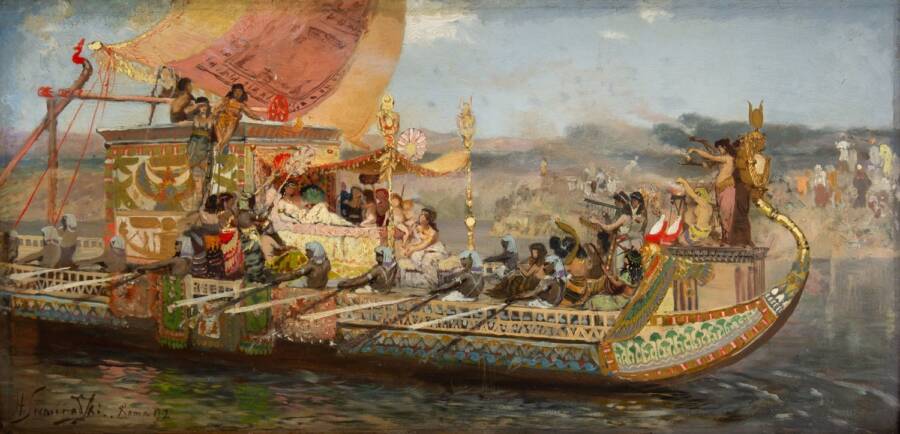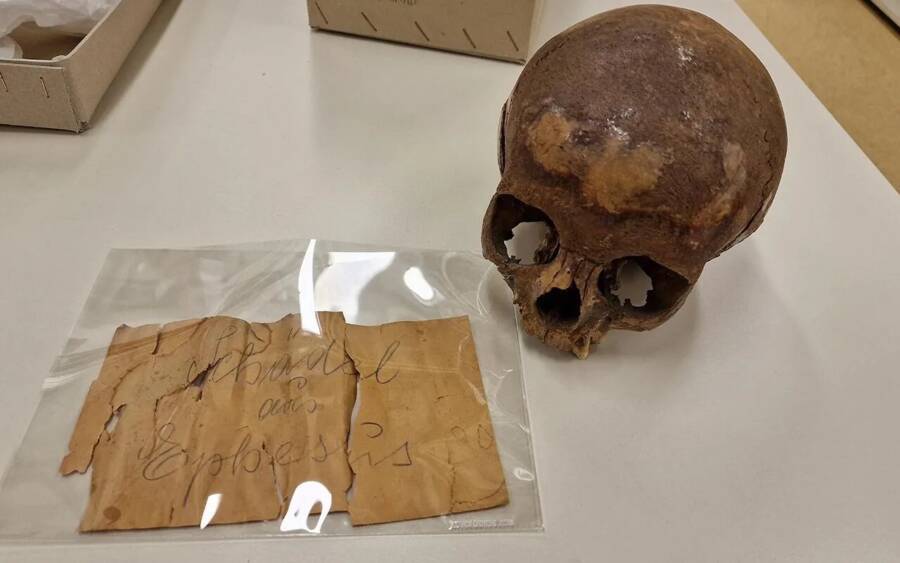After she challenged her sister Cleopatra's rule, Arsinoe IV was brutally killed by Mark Antony's assassins in the Temple of Artemis at Ephesus in 41 B.C.E.

Gemäldegalerie Alte MeisterTintoretto’s depiction of Arsinoe IV attempting to flee Julius Caesar.
Arsinoe IV was the youngest sister of the Egyptian queen Cleopatra — and she became a tragic victim of her powerful sibling’s political plots.
Amidst the Alexandrian War, Arsinoe had attempted to lead a rebellion against Cleopatra, who had formed an alliance with Julius Caesar. Just a teenager at the time, Arsinoe also tried to take Cleopatra’s throne.
But the rebellion was unsuccessful, and Arsinoe IV was sent to Rome as a political prisoner. Though she initially avoided execution and was allowed to become a priestess at the Temple of Artemis at Ephesus, she wouldn’t be safe long. Cleopatra was so concerned that Arsinoe would try to challenge her rule again that she orchestrated her own sister’s murder in 41 B.C.E.
Arsinoe IV’s Early Life As A Ptolemaic Princess
Egypt’s Ptolemaic rulers had a complicated family tree. King Ptolemy XII Auletes counted among his children at least three queens and two kings. How did one family produce so many rulers? The Ptolemaic royals apparently had a bad habit of executing each other. (Indeed, Cleopatra is believed to have been involved not only in the death of Arsinoe, but also at least two of her other siblings, Ptolemy XIII and Ptolemy XIV.)
Arsinoe IV, the youngest daughter in the family who may have technically been a half-sister to Cleopatra, was not ever supposed to be in line for the throne. But everything changed after she attempted to lead a rebellion against her sister Cleopatra to take control of Egypt.

Wikimedia CommonsWhile the Ptolemaic royal family members lived lives of luxury, holding too much power in the family could be deadly.
Since Arsinoe IV was younger than all of her sisters, born sometime in the 60s B.C.E., her birth order made her largely irrelevant in the eyes of most Egyptians. She also had brothers, who were often prioritized for the throne even though she was older than them. Still, like other royal daughters, Arsinoe had the opportunity to study topics like politics and philosophy. Her tutor, a eunuch named Ganymedes, also served as her legal guardian.
In 58 B.C.E., the eldest daughter in the family, Berenike IV, stole their father Ptolemy XII’s throne, sending some of her siblings into exile with him, including Cleopatra and Arsinoe. This led the sisters to Rome, where Ptolemy XII convinced figures like Julius Caesar to help him reclaim his throne.
Two years later, in 56 B.C.E., Ptolemy XII swept back into Egypt, executing his daughter Berenike IV and naming the young Cleopatra as his co-ruler.
But when Ptolemy XII died, Egypt was soon plunged into upheaval, and the ensuing chaos nearly led to Arsinoe IV ending up on Egypt’s throne.
A Rivalry Between Cleopatra And Arsinoe IV
Historical records are largely silent about the relationship between Cleopatra and Arsinoe IV when they were young children. But once Cleopatra became queen, it’s clear that the relationship between the two soured.
Cleopatra was around 18 years old when her father died, and Egypt’s rule was then left to her and her 10-year-old brother Ptolemy XIII. Royal advisors who disliked Cleopatra soon pressured the young boy to exile his sister. It seemed that some of the advisors wanted to replace Cleopatra with Arsinoe, who was younger and perhaps easier to manipulate.
However, Cleopatra took Arsinoe with her in exile. Some believe she initially saw her sister as an ally, but others think she treated her as a hostage.
Following her father’s playbook, Cleopatra turned to Rome for help retaking her kingdom. Julius Caesar proved a willing partner to Cleopatra (both politically and romantically), insisting on her reinstatement.

Museum of Fine Arts of LyonThis artwork is believed to show Arsinoe IV on the right, angry as Julius Caesar confirms Cleopatra’s rule.
Arsinoe IV and Cleopatra were soon welcomed back into Alexandria with Caesar’s help. But Caesar, worried about his own position in Egypt, insisted that all the possible Ptolemaic heirs remain in the palace, where armed guards kept an especially close eye on Cleopatra and Arsinoe.
The rise of Roman power in Egypt triggered riots among the local population, and in 48 B.C.E., Egyptian rioters pressured Caesar to retreat to Cyprus. As Egyptians marched on Alexandria to retake their capital from the Romans, Arsinoe escaped with her tutor and legal guardian, Ganymedes.
Since Arsinoe was the only Ptolemaic heir who was apparently outside of Caesar’s control, the Egyptians rallied to her side, eventually declaring her their queen. For a while, it seemed that Arsinoe was taking control of Egypt. But Caesar outwitted the Egyptians, releasing young Ptolemy XIII with the hope that a competing male heir would destroy Arsinoe’s position.
Caesar’s prediction proved true. The Egyptian soldiers soon turned on Arsinoe, and the ensuing chaos gave Caesar plenty of time to send for reinforcements and to crush the Egyptian uprising. After the dust settled at the Battle of the Nile and Ptolemy XIII died, Cleopatra later emerged as the sole ruler of Egypt. Meanwhile, Arsinoe became a prisoner of war.
Inside Arsinoe’s Imprisonment And Brutal Murder
Julius Caesar did not care that Arsinoe was the aunt of Caesarion, Cleopatra’s first son who was likely fathered by Caesar. Caesar saw Arsinoe as someone who had led a failed rebellion against Cleopatra — and one of many captured rulers who proved how powerful Rome was.
Caesar returned to Rome triumphant in 46 B.C.E., celebrating his conquest of Egypt, Gaul, Pontus, and other regions with a massive parade. And Arsinoe IV was forced to march through the streets of Rome wrapped in gold chains — one of the only female rulers who was subjected to such humiliation.

The Metropolitan Museum of ArtJulius Caesar’s triumphant marches through Rome featured multiple captured rulers.
While Caesar ordered Ganymedes’ execution, he decided to spare Arsinoe’s life after the triumph. After all, further humiliating Egypt and the Ptolemaic dynasty could have potentially destabilized Caesar’s power.
Arsinoe was then permitted to become a priestess of the Temple of Artemis at Ephesus, a position that was supposed to prevent her from claiming the Egyptian throne. Still, some critics of Cleopatra whispered that Arsinoe would make a better queen, sparking rumors that she might return to power.
Meanwhile, Julius Caesar’s assassination in 44 B.C.E. soon plunged Rome into civil war and destabilized Cleopatra’s rule. She quickly allied herself with one of Caesar’s successors, Mark Antony, eventually pressuring her new political and romantic ally to take out a threat to her rule: Arsinoe.

Ferdinand Knab/Wikimedia CommonsOne of the Seven Wonders of the Ancient World, the Temple of Artemis was where Arsinoe spent her final days.
Antony, who was eager to do anything to help Cleopatra, agreed to send assassins to the Temple of Artemis at Ephesus to kill Arsinoe IV in 41 B.C.E. Arsinoe was only in her 20s when she was murdered, and since she was killed at the temple, this was widely viewed as offensive to the gods.
Still, Antony and Cleopatra would maintain their power for years before their own deaths. Cleopatra apparently always remembered the humiliation that her sister had faced as a defeated ruler marched through the streets of Rome. So when Antony’s rival Octavian eventually defeated Antony and Cleopatra and prepared to seize all control of Egypt, Cleopatra killed herself in 30 B.C.E. rather than face the same punishment that Arsinoe endured.
The Complicated Legacy Of Arsinoe IV — And The Mystery Of Her Resting Place

Gerhard Weber/University of ViennaThis skull, uncovered in Ephesus in 1929, was long wrongly believed to belong to Arsinoe IV.
During Arsinoe IV’s early years, contemporary writers rarely mentioned her. Though she was the daughter of a king, she was seen as inconsequential at first. That is, until Arsinoe became the face of Egyptian defiance of the Romans — and then the symbol of Rome’s conquest of Egypt.
Then, Arsinoe’s mere existence made her a threat to Cleopatra, who brutally orchestrated her sister’s murder to reinforce her political position.
Centuries later, historians now have diverse views on Arsinoe. Some see her as a traitor for rebelling against her sister and trying to take her throne. Those sympathetic to Cleopatra’s actions often claim that the assassination of Arsinoe was a necessary choice to preserve Cleopatra’s reign.
But others see her as a victim of Cleopatra’s tyranny, especially considering Arsinoe’s young age during her initial rebellion. Some have pointed out that Arsinoe probably had older tutors who were determined to increase their own power, likely influencing the fateful decisions she made.
And since Cleopatra ordered Antony to kill Arsinoe, one writer even compared the murder to Cleopatra receiving a “sacrifice” from her lover.

Wikimedia CommonsCleopatra is perhaps best known today for her beauty and brilliance, but her reign was far from peaceful.
Aside from Arsinoe’s violent death and her complex legacy, another ongoing topic of interest is the Ptolemaic princess’ final resting place.
Like many of the other Wonders of the Ancient World, the Temple of Artemis eventually crumbled, but an elaborate tomb survived. Chiseled from marble, the tomb contained a skull. When archaeologists discovered the skull in 1929, many wondered if it could be part of the remains of Arsinoe. The mystery deepened when the rest of the skeleton was found decades later.
However, a recent analysis revealed that the skeleton did not belong to Cleopatra’s sister, but rather to a young boy who was between 11 and 14 years old and potentially had a developmental disorder. And so, Arsinoe’s real remains are still undiscovered — and her resting place remains a mystery.
Next, learn about the tumultuous life and mysterious death of Cleopatra Selene II, the only daughter of Cleopatra and Mark Antony. Then, go inside the unsolved ancient mystery of how the Egyptian pyramids were built. Finally, go inside the search for Cleopatra’s tomb.





